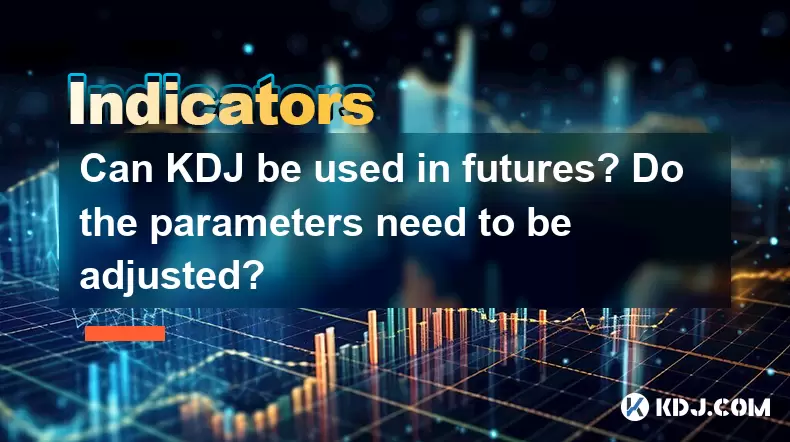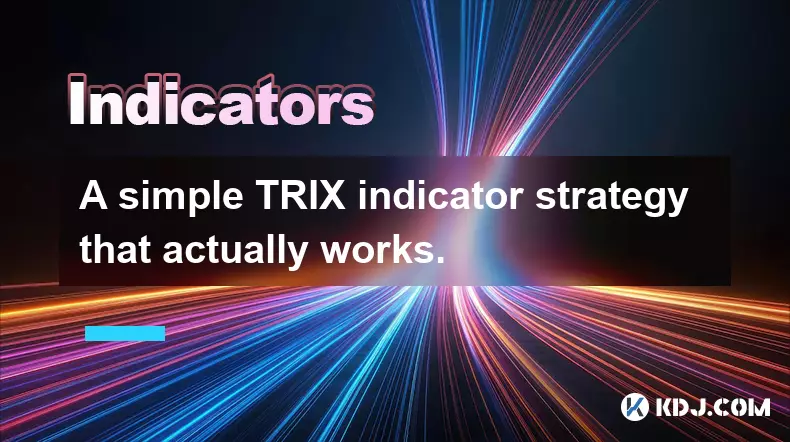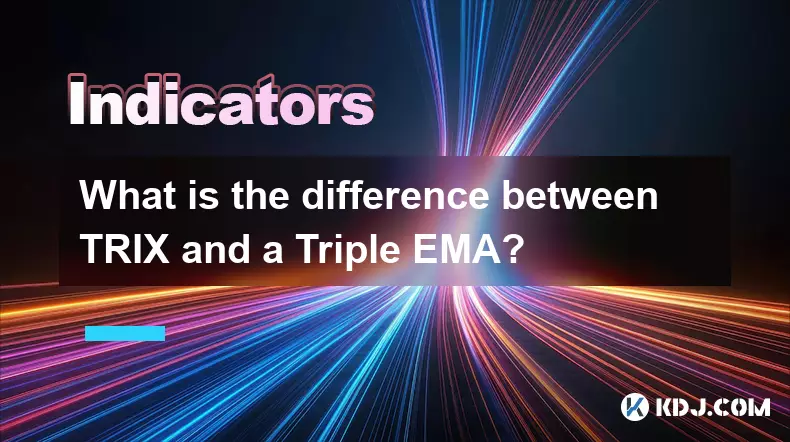-
 bitcoin
bitcoin $105968.894684 USD
4.17% -
 ethereum
ethereum $3639.320047 USD
7.62% -
 tether
tether $1.000339 USD
0.06% -
 xrp
xrp $2.407774 USD
5.96% -
 bnb
bnb $1011.704193 USD
2.28% -
 solana
solana $166.942754 USD
6.37% -
 usd-coin
usd-coin $1.000143 USD
0.03% -
 tron
tron $0.291515 USD
0.25% -
 dogecoin
dogecoin $0.181682 USD
4.06% -
 cardano
cardano $0.585450 USD
4.54% -
 hyperliquid
hyperliquid $42.099968 USD
5.20% -
 chainlink
chainlink $16.160745 USD
5.45% -
 zcash
zcash $645.269648 USD
12.96% -
 bitcoin-cash
bitcoin-cash $507.430338 USD
2.80% -
 stellar
stellar $0.290357 USD
3.69%
Can KDJ be used in futures? Do the parameters need to be adjusted?
The KDJ indicator, useful for identifying trend reversals, can be optimized for cryptocurrency futures by adjusting its parameters to suit the market's volatility.
May 23, 2025 at 06:35 am

Introduction to KDJ Indicator
The KDJ indicator, also known as the Stochastic Oscillator, is a popular technical analysis tool used to identify potential trend reversals in the market. Originally developed for the stock market, its application has extended to various financial instruments, including cryptocurrency futures. The KDJ indicator consists of three lines: K, D, and J, which oscillate between 0 and 100 to indicate overbought or oversold conditions. The primary question is whether this indicator can be effectively used in the volatile world of cryptocurrency futures and if the parameters need to be adjusted for optimal performance.
Applying KDJ to Cryptocurrency Futures
Using the KDJ indicator in cryptocurrency futures trading can be beneficial due to its ability to signal potential entry and exit points. The volatility of futures markets, particularly in cryptocurrencies, makes it crucial to have a reliable tool to gauge market sentiment and momentum. The KDJ can help traders identify when the market is overbought or oversold, which can be particularly useful in the fast-paced environment of futures trading.
Standard KDJ Parameters and Their Relevance
The standard parameters for the KDJ indicator are typically set as follows: 9 periods for the fast K line, 3 periods for the slow D line, and 3 periods for the J line. These settings are designed to provide a balance between sensitivity and reliability in traditional markets. However, the cryptocurrency futures market is known for its higher volatility and rapid price movements, which may necessitate adjustments to these parameters to better suit the unique characteristics of this market.
Adjusting KDJ Parameters for Futures Trading
To optimize the KDJ indicator for cryptocurrency futures, traders may need to adjust the parameters to account for the increased volatility and speed of price movements. Here are some considerations for adjusting the KDJ parameters:
- Shortening the Periods: Reducing the number of periods used in calculating the K, D, and J lines can make the indicator more responsive to rapid price changes. For example, setting the fast K line to 5 periods instead of 9 can help capture quicker market shifts.
- Lengthening the Periods: Conversely, increasing the number of periods can help smooth out the indicator's signals and reduce false positives, which can be beneficial in highly volatile markets. For instance, setting the slow D line to 5 periods instead of 3 might provide more stable signals.
- Experimentation: Traders should experiment with different parameter settings to find the optimal balance that suits their trading style and the specific cryptocurrency futures they are trading.
Practical Application of KDJ in Futures Trading
Implementing the KDJ indicator in cryptocurrency futures trading involves a few key steps. Here's how traders can effectively use the KDJ to make informed trading decisions:
- Monitor Overbought and Oversold Levels: The KDJ indicator signals overbought conditions when the lines cross above 80 and oversold conditions when they cross below 20. Traders can use these levels to anticipate potential trend reversals.
- Look for Crossovers: A bullish signal occurs when the K line crosses above the D line, while a bearish signal is indicated when the K line crosses below the D line. The J line can be used to confirm these signals.
- Combine with Other Indicators: To increase the reliability of KDJ signals, traders should consider combining them with other technical indicators such as Moving Averages or Relative Strength Index (RSI).
Example of KDJ Trading Strategy in Futures
Here's a detailed example of how a trader might use the KDJ indicator in cryptocurrency futures trading:
- Identify the Trend: First, the trader assesses the overall trend of the futures market using a longer-term moving average, such as a 50-day MA.
- Use KDJ for Entry and Exit Points: If the market is in an uptrend, the trader looks for the KDJ lines to cross above 20 as a potential entry point. Conversely, if the market is in a downtrend, the trader watches for the KDJ lines to cross below 80 as a potential entry point.
- Set Stop-Loss and Take-Profit Levels: To manage risk, the trader sets a stop-loss order just below the recent swing low for long positions or above the recent swing high for short positions. Take-profit levels can be set at key resistance or support levels identified on the chart.
- Monitor and Adjust: The trader continuously monitors the KDJ signals and adjusts their positions accordingly, using the indicator to identify potential trend reversals and adjust stop-loss and take-profit levels as needed.
Conclusion
In summary, the KDJ indicator can be a valuable tool for traders in the cryptocurrency futures market. By understanding its standard parameters and making necessary adjustments to suit the unique characteristics of futures trading, traders can enhance their ability to identify potential entry and exit points. Combining the KDJ with other technical indicators and following a disciplined trading strategy can help maximize its effectiveness in this dynamic market environment.
Frequently Asked Questions
Q: Can the KDJ indicator be used for day trading in cryptocurrency futures?A: Yes, the KDJ indicator can be effectively used for day trading in cryptocurrency futures. Its ability to quickly signal overbought and oversold conditions makes it suitable for short-term trading strategies. However, traders should be cautious of false signals and consider using shorter periods for the K, D, and J lines to increase responsiveness to intraday price movements.
Q: How does the KDJ indicator perform during high volatility in cryptocurrency futures?A: During periods of high volatility, the KDJ indicator can provide valuable insights into potential trend reversals. However, its signals may become more frequent and less reliable due to rapid price fluctuations. Traders can mitigate this by adjusting the indicator's parameters, such as shortening the periods to capture quicker market shifts or using other indicators to confirm KDJ signals.
Q: Is it necessary to use the J line in the KDJ indicator for futures trading?A: While the J line is part of the KDJ indicator, its use is optional and depends on the trader's strategy. The J line can help confirm signals generated by the K and D lines, but some traders may find it adds unnecessary complexity. Experimenting with and without the J line can help determine its usefulness in a specific trading approach.
Q: Can the KDJ indicator be used in conjunction with fundamental analysis in cryptocurrency futures trading?A: Yes, the KDJ indicator can be used alongside fundamental analysis in cryptocurrency futures trading. While the KDJ focuses on technical signals, fundamental analysis can provide insights into market sentiment and potential price drivers. Combining both approaches can help traders make more informed decisions and improve their overall trading strategy.
Disclaimer:info@kdj.com
The information provided is not trading advice. kdj.com does not assume any responsibility for any investments made based on the information provided in this article. Cryptocurrencies are highly volatile and it is highly recommended that you invest with caution after thorough research!
If you believe that the content used on this website infringes your copyright, please contact us immediately (info@kdj.com) and we will delete it promptly.
- Ripple (XRP) in 2026: Hold or Fold? A Look at XRP's Future and Emerging DeFi Alternatives
- 2025-11-08 18:35:01
- Zcash ZEC Coin Price Explosion: From Privacy Niche to Center Stage
- 2025-11-08 18:55:01
- Berachain Price Prediction: Navigating the Honeycomb Hype in Crypto
- 2025-11-08 18:55:01
- Arthur Hayes, Gold, and Bitcoin: A Modern Monetary Trinity?
- 2025-11-08 19:15:01
- Shiba Inu's Next Move: Navigating a Shifting Market
- 2025-11-08 19:20:01
- Pakistan's Crypto Crossroads: Balancing Opportunity with Asset-Backed Realities
- 2025-11-08 19:20:01
Related knowledge

How do professional traders use the TRIX indicator?
Nov 06,2025 at 04:40pm
Understanding the TRIX Indicator in Crypto TradingThe TRIX (Triple Exponential Average) indicator is a momentum oscillator used by professional trader...

Can I use the TRIX indicator on my mobile trading app?
Nov 07,2025 at 07:40pm
The TRIX indicator, a momentum oscillator designed to filter out short-term fluctuations and highlight long-term trends, has become increasingly popul...

How to code a simple TRIX indicator script in Pine Script?
Nov 07,2025 at 06:20am
How to Code a Simple TRIX Indicator in Pine Script The TRIX (Triple Exponential Moving Average) indicator is widely used in cryptocurrency trading to ...

A simple TRIX indicator strategy that actually works.
Nov 08,2025 at 05:39pm
Understanding the TRIX Indicator in Crypto Trading1. The TRIX (Triple Exponential Average) indicator is a momentum oscillator designed to filter out s...

What is the difference between TRIX and a Triple EMA?
Nov 10,2025 at 04:00am
Understanding Decentralized Exchanges in the Crypto Ecosystem1. Decentralized exchanges (DEXs) have emerged as a cornerstone of blockchain innovation,...

How to trade TRIX indicator signals on the 1-hour chart?
Nov 07,2025 at 05:39am
Bitcoin's Role in Decentralized Finance1. Bitcoin remains the cornerstone of decentralized finance, serving as a benchmark for value and security acro...

How do professional traders use the TRIX indicator?
Nov 06,2025 at 04:40pm
Understanding the TRIX Indicator in Crypto TradingThe TRIX (Triple Exponential Average) indicator is a momentum oscillator used by professional trader...

Can I use the TRIX indicator on my mobile trading app?
Nov 07,2025 at 07:40pm
The TRIX indicator, a momentum oscillator designed to filter out short-term fluctuations and highlight long-term trends, has become increasingly popul...

How to code a simple TRIX indicator script in Pine Script?
Nov 07,2025 at 06:20am
How to Code a Simple TRIX Indicator in Pine Script The TRIX (Triple Exponential Moving Average) indicator is widely used in cryptocurrency trading to ...

A simple TRIX indicator strategy that actually works.
Nov 08,2025 at 05:39pm
Understanding the TRIX Indicator in Crypto Trading1. The TRIX (Triple Exponential Average) indicator is a momentum oscillator designed to filter out s...

What is the difference between TRIX and a Triple EMA?
Nov 10,2025 at 04:00am
Understanding Decentralized Exchanges in the Crypto Ecosystem1. Decentralized exchanges (DEXs) have emerged as a cornerstone of blockchain innovation,...

How to trade TRIX indicator signals on the 1-hour chart?
Nov 07,2025 at 05:39am
Bitcoin's Role in Decentralized Finance1. Bitcoin remains the cornerstone of decentralized finance, serving as a benchmark for value and security acro...
See all articles





















![The Graph Price Prediction [GRT Crypto Price News Today] The Graph Price Prediction [GRT Crypto Price News Today]](/uploads/2025/11/07/cryptocurrencies-news/videos/690d4df44fe69_image_500_375.webp)




















































